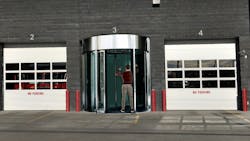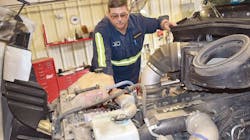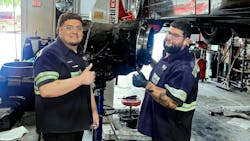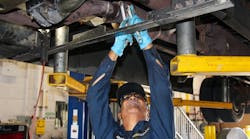For all the time and money you spend bringing new technicians into the shop and getting them up to speed, it’s all for naught if they can’t be retained within your walls. Turnover is a problem across the industry, notably with drivers, but having a revolving door where techs are out as fast as they come in may have the biggest impact on uptime.
“When a good technician leaves, they do not just walk out with their tools,” said Jim Eisenberger, a former technician and founder and CEO of Pinpoint, a platform to assist techs with diagnostics and repairs. “They take years of experience and real-world problem-solving knowledge with them.” That kind of loss creates a “ripple effect” that can take three to five years to recover from, Eisenberger said. That’s how much time it can take to train new techs to build the diagnostic intuition and skills they need.
“Most do not make it that far,” he said.
Around 14% of technicians left their jobs in the first two years, according to Fleet Maintenance affiliate Ratchet+Wrench’s 2023 Industry Survey Report. A 2021 ASE Education Foundation study put that at 41%.
Techs have dozens of reasons to leave (life happens), but there’s one big mistake shops make, according to Bill Black, CEO and president of National Fleet Management Inc.
“The problem with turnover is typically during the selection process, not the actual employment process,” Black said. Simply put, shops don’t properly screen candidates.
He said techs might also exaggerate their skill level or become disenchanted with the pay structure. Or maybe both parties find out the relationship is a bad fit and need to break up.
But that can’t be the reason why turnover is as bad as it is. Leadership must have some control and accountability over the situation. The fact is turning wrenches is a hard job, one made harder with poor management and stagnant pay. Add to that increasing complexity and competition in the shop, it’s not difficult to understand why that revolving door exists.
“That is what the job has become,” Eisenberger asserted. “And for many, it is just not worth it anymore.”
So, the question now is how can management make the job worth it? Here are five areas to address in your shop.
1. Fair compensation
Competitive hourly pay and steady hours is step one to keeping techs in your shop, according to Matt Trapp, VP of operations at Fleet Services by Cox Automotive.
“The technicians want to be busy,” Trapp noted. “And when they start to see a slowdown, or they see an area where it dries up, then they start getting nervous and look for other opportunities.”
And while it is on a technician to make sure they’re working efficiently and getting jobs done on time, it’s not their job to hunt for work.
“Keeping their calendar full, having them attain their hours and earn overtime—those are meaningful to the technicians,” Trapp emphasized.
On a related note, stagnant wages are a quick way to drive technicians out your door, added Arthur Lon, sr. director of talent management at Fleet Services. It’s basic advice, but sometimes the easiest solutions are also the most accurate.
“It is, unfortunately, a lot easier to get a higher pay bump by switching companies, as opposed to sticking around and waiting for that annual increase, if that’s even a thing,” Lon said. So one way to keep technicians in your shop is to make sure this isn’t true. Offer your techs pay transparency, so they know what metrics impact their pay, understand what they need to do to get a raise, and know how much they’ll get.
And, in some cases, this provides just cause to reexamine how you compensate employees, too.
“That means designing a pay structure that actually works for the people fixing the cars,” Eisenberger said. “It means treating techs like humans, not machines with a socket in their hand.”
2. Provide good benefits
Of course, along with pay, a competitive benefits package is critical. Some of the most basic options to offer include healthcare and dental insurance, as well as a 401K match. But a bad plan that requires high premiums might not make up for a slightly higher wage, forcing a tech to find higher take-home pay elsewhere. In Wrench Way’s most recent Voice of Technician survey, 47% of respondents said their shop did not provide good benefits. So make sure your benefits are in line with or better than other shops in the region.
You can also set yourself apart with tool insurance, which Transervice Logistics offers, according to Kari Beeson, VP of recruitment and risk management.
“Because it’s so minimal, it’s part of our overall insurance program that we have to have in order to operate,” Beeson explained. “It never hurts to have, and it’s great to know that you have additional coverage.”
You could even offer pet insurance.
“[Pet insurance is] something that stands out to people,” said Jacob Leach, sr. mobile diesel technician at Cox Automotive. “I won’t say that that’s one of the most important benefits, but I’ll say that definitely helps them stand out as a company that goes the extra mile for employees.”
These benefits sweeten the pot for techs and show that you care about their overall well-being.
3. Don’t shy away from tools, equipment, and gifts
For Voice of Technician respondents, having adequate tools and equipment in the shop was the top thing students and techs looked for in a potential shop. At Cox Automotive, that extends into making sure that their mobile technicians have what they need and that they’ll be comfortable in their service trucks.
“It ties together to ensure that the employee feels that they are valued and they want to stick around,” Lon explained.
This means getting their technicians’ input on making sure their vehicles’ doors open well, that the drawers allow them to easily store their tools, and that the trucks are secure places to keep parts and components.
Additionally, keeping your technicians onboard may mean updating your systems, too. Leach recalled how one of the reasons he returned to work for Fleet Services after trying another company was that the service trucks and technology weren’t properly set up to funciton as a virtual office.
“We were using our personal telephones for work,” he said. “And then on top of that, we were using paper. They weren’t really set up for the tools and resources as much as we are here at Fleet Services.”
Beyond functional equipment, some more cosmetic additions never hurt, too, in terms of keeping technicians happy. For instance, Lon said Cox’s technicians have enjoyed using Apple’s CarPlay to listen to their music in their trucks, and that Remote Start is great to cope with the weather.
For other gift ideas, National Fleet Management’s Black said that his employees really appreciate the annual Christmas party and summer event the company puts on for them and their families. Not only are the “epic” parties a blast for the kids, with the Christmas festivities including gifts, a magic show, face paint, and a visit from Santa Claus, but the adults can win prizes, too. Black noted that they’ve raffled off a week-long resort trip to Disney World (plus spending money), four-day weekends at resorts with $400-$500 of spending money, and the ever-popular big-screen TV.
“It’s funny, because the prize everybody wants to win is the big-screen TV, and it’s usually the least-expensive gift,” Black laughed.
But if those exceed your budget, easier gifts can include tool allowances and outerwear for your techs. Beeson noted that their tool allowance ranges from $500-$1,000, and that they offer boot allowances and provide (and wash) their techs’ uniforms, too. And when winter rolls around, Transervice offers new outerwear as well.
The recruitment/retention issue by numbers
Turnover and worker loss in the trades: TechForce Foundation found that replacing positions due to turnover and retirement outpaced those due to growth at a rate of 4:1 in 2024.
The cost of hiring: Boulo, a recruiting service, found it costs an average of $5,000 to hire a new person.
Productivity loss due to hiring: Growthforce reported that it takes up to five months for new hires to reach full productivity.
What drives employees to leave: The Society of Human Resource Management found that from ’23-’24, 32% of employees quit their job due to a toxic or negative work environment. Thirty percent left due to poor company leadership.
No path to success: In WrenchWay’s 2025 Voice of Technician survey, only 35% of diesel techs said their shop offered a well-laid-out career path, 21% fewer than in 2024.
Work week: According to WrenchWay, 93% of technicians don’t like working on the weekends.
4. Pave a clear career path
Beeson noted that, especially for the next generation of technicians, career advancement is a necessity.
“They’re really looking for that career path to grow,” she explained. “And if they can’t find it, they will jump ship very fast… if you can’t compensate and keep up with their growing, then they’ll go somewhere else.”
Luckily, there are plenty of options to show techs a path to their future. Lon explained that Cox allows technicians to try assignments on various other teams, such as in billing or estimating, so that as wrenching wears on their bodies, techs know that they still have other career options at the company.
Meanwhile at Transervice, Beeson said that they not only help their techs get their ASE certifications and help pay for tests, but also will actively
guide techs toward management roles through higher education.
“We offer classes for them to take, especially for [Microsoft] Excel, because when you start getting to the management level, you’re talking P&Ls, and you’re talking a financial acumen that you should have,” Beeson explained. “So if they want to take courses, even if they don’t want to get a degree, to better understand business, then we’ll reimburse them for that.”
5. Ensure your culture is up to snuff
While having a strong shop culture sounds like a vague retention tactic at the best of times, it’s still one that works.
“We’ve had people where they left because of money, but then they came back because the culture wasn’t there,” Beeson asserted.
That means making sure that managers know how to coach their techs, and that your techs can easily communicate with their managers about their concerns.
“The best shops invite technicians into process decisions,” Eisenberger added. “That kind of respect goes further than any bonus ever could.”
And while having a strong culture does mean making sure leadership and management are qualified and communicative with their technicians, shops can also be creative in making sure their techs feel taken care of in other ways. For Black, that means having a chaplain come by once a week to offer their technicians support.
“It’s kind of like a mental-health type thing, it’s not just about God or church,” Black said. “It’s more about counseling.”
All of this can help increase a technician’s stability and decrease their stress, showing them that their shop is one that wants them there for the long haul.
“The number-one reason that I came back is there’s a lot more stability here,” Leach concluded on why he returned to Fleet Services by Cox Automotive. “I can be happier and be way more efficient as a technician, and if you’re not being efficient, then you can’t be happy, in my personal opinion.”
About the Author

Alex Keenan
Alex Keenan is an Associate Editor for Fleet Maintenance magazine. She has written on a variety of topics for the past several years and recently joined the transportation industry, reviewing content covering technician challenges and breaking industry news. She holds a bachelor's degree in English from Colorado State University in Fort Collins, Colorado.



